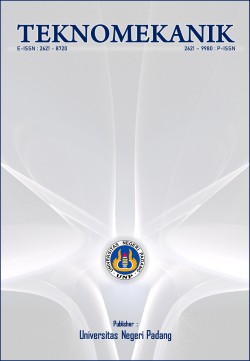The development of movement system of the second six-legged robot PTE UNIMA
DOI:
https://doi.org/10.24036/jptk.v4i4.21323Keywords:
Hexapod, Motion system of a legged robot, Robot development, Tripod gaitAbstract
Engineering technology in robotics for the present era is no longer new, especially in high education, marked by Indonesian robot contests routinely held annually by the national achievement center. The participants in this event are groups of students from all higher education institutions spread throughout Indonesia. The development of robotics technology is now faster to spur individuals and students to compete to conduct research and development in robotics. The study aims to develop a six-legged robotic motion system or so-called hexapod. The research was conducted using the Addie model research method consisting of five stages, namely, analyze stage to analyze the needs of the development of the robotic motion system and analysis of the needs of tools and materials to be used. The design stage of designing the mechanical structure of the robot both in terms of hardware and in terms of robot software, the development stage of developing a six-legged robot's motion system to be more stable and more efficient in moving, the implementation stage is a test stage of the robot's motion system that has been developed. The evaluation stage is the last stage of this development research; at this stage, the evaluation is done to ensure the robot's motion system is feasible to use.
Downloads
References
D., & Wahyudi, R. (2015). Kontrol Kecepatan Robot Hexapod Pemadam Api menggunakan Metoda Logika Fuzzy. Jurnal Nasional Teknik Elektro, 4(2), 227. https://doi.org/10.25077/jnte.v4n2.170.2015
Akhtaruzzaman, M., Bt Samsuddin, N. I., Bt Umar, N., & Rahman, M. (2009). Design and development of a wall climbing robot and its control system. ICCIT 2009 - Proceedings of 2009 12th International Conference on Computer and Information Technology, 309–313. https://doi.org/10.1109/ICCIT.2009.5407120
Brandenbourger, M., Locsin, X., Lerner, E., & Coulais, C. (2019). Non-reciprocal robotic metamaterials. Nature Communications, 10(1), 1–8. https://doi.org/10.1038/s41467-019-12599-3
Budiharto, W. (2006). Belajar Sendiri: Membuat Robot Cerdas. Elex Media Komputindo. https://books.google.com/books?hl=en&lr=&id=_Ugs0C6egWsC&oi=fnd&pg=PR7&dq=sumber+daya+robotik+di+bidang+industri&ots=jPUjjSNKye&sig=_b1LFMhXfEzkf3BjZ-iDElcpNog
Burgard, W., Fox, D., & Hennig, D. (1997). Fast grid-based position tracking for mobile robots. Lecture Notes in Computer Science (Including Subseries Lecture Notes in Artificial Intelligence and Lecture Notes in Bioinformatics), 1303, 289–300. https://doi.org/10.1007/3540634932_23
Chen, J., Gao, F., Huang, C., & Zhao, J. (2019). Whole-body motion planning for a six-legged robot walking on rugged terrain. Applied Sciences (Switzerland), 9(24), 11–13. https://doi.org/10.3390/app9245284
Darwison, Rusydi, I., & Imran, I. H. (2011). Perancangan dan Pembuatan Sistem Kontrol Kecepatan Servomotor Continous Parallax dengan PID. Teknika, 1. https://ft.unand.ac.id/profil/program/riset/publikasi
Devjanin, E. A., Gurfinkel, V. S., Gurfinkel, E. V., Kartashev, V. A., Lensky, A. V., Shneider, A. Y., & Shtilman, L. G. (1983). The six-legged walking robot capable of terrain adaptation. Mechanism and Machine Theory, 18(4), 257–260. https://doi.org/10.1016/0094-114X(83)90114-3
Halim, S. (2007). Merancang Mobile Robot Pembawa Objek Menggunakan OOPic-R. In PT Elex Media Komputindo. PT Elex Media Komputindo. https://books.google.co.id/books?id=_35D5i96W2IC&pg=PR4&lpg=PR4&dq=Halim,+Sandy.+2007.+“Merancang+Mobile+Robot+Pembawa+Objek+Menggunakan+OOPic-R”+PT+Elex+Media+Komputindo,+Jakarta&source=bl&ots=_4Xp9Rq8bG&sig=ACfU3U0txpEfIHUtHr1eQoawsAFmblyX7g&hl=id&sa=X&
Kadir, A. (2013). Panduan Praktis Memplajari Aplikasi Mikrokontroler dan Pemogramannya Menggunakan Arduino. In Andi Komputindo (Vol. 8, Issue 1). Andi Offset.
Maulana, R. H. (n.d.). Penerapan Behavior Based Robotic Pada Sistem Navigasi Dan Kontrol Robot Soccer.
Molenda, M. (2003). In search of the elusive ADDIE model. Performance Improvement, 42(5), 34–36. https://doi.org/10.1002/pfi.4930420508
Puspresnas. (2019). Ajang Talenta Dikti. Puspresnas Kemdikbud. https://pusatprestasinasional.kemdikbud.go.id/jenjang/dikti
Ramadhan, M. F. (2017). Perancangan Kontrol Stabilitas Hexapod Robot Menggunakan Metode Neuro-Fuzzy. http://repository.its.ac.id/44113/
Sethi, S. P., Sriskandarajah, C., Sorger, G., Blazewicz, J., & Kubiak, W. (1992). Sequencing of parts and robot moves in a robotic cell. International Journal of Flexible Manufacturing Systems, 4(3–4), 331–358. https://doi.org/10.1007/BF01324886
Soyguder, S., & Alli, H. (2007). Design and prototype of a six-legged walking insect robot. Industrial Robot, 34(5), 412–422. https://doi.org/10.1108/01439910710774412
Utama, A. W. T. (2018). Pengembangan Sistem Robot Berkaki Enam(Hexapod) Menggunakan Metode Behavior Based Control pada Kontes Robot Pemadam Api Berkaki.
Zhang, J., Wang, Y., & Xiong, R. (2016). Industrial robot programming by demonstration. ICARM 2016 - 2016 International Conference on Advanced Robotics and Mechatronics, 300–305. https://doi.org/10.1109/ICARM.2016.7606936
Downloads
Published
How to Cite
Issue
Section
License
Copyright (c) 2021 Calvin E J Mamahit, Mildes Sanggola

This work is licensed under a Creative Commons Attribution 4.0 International License.





